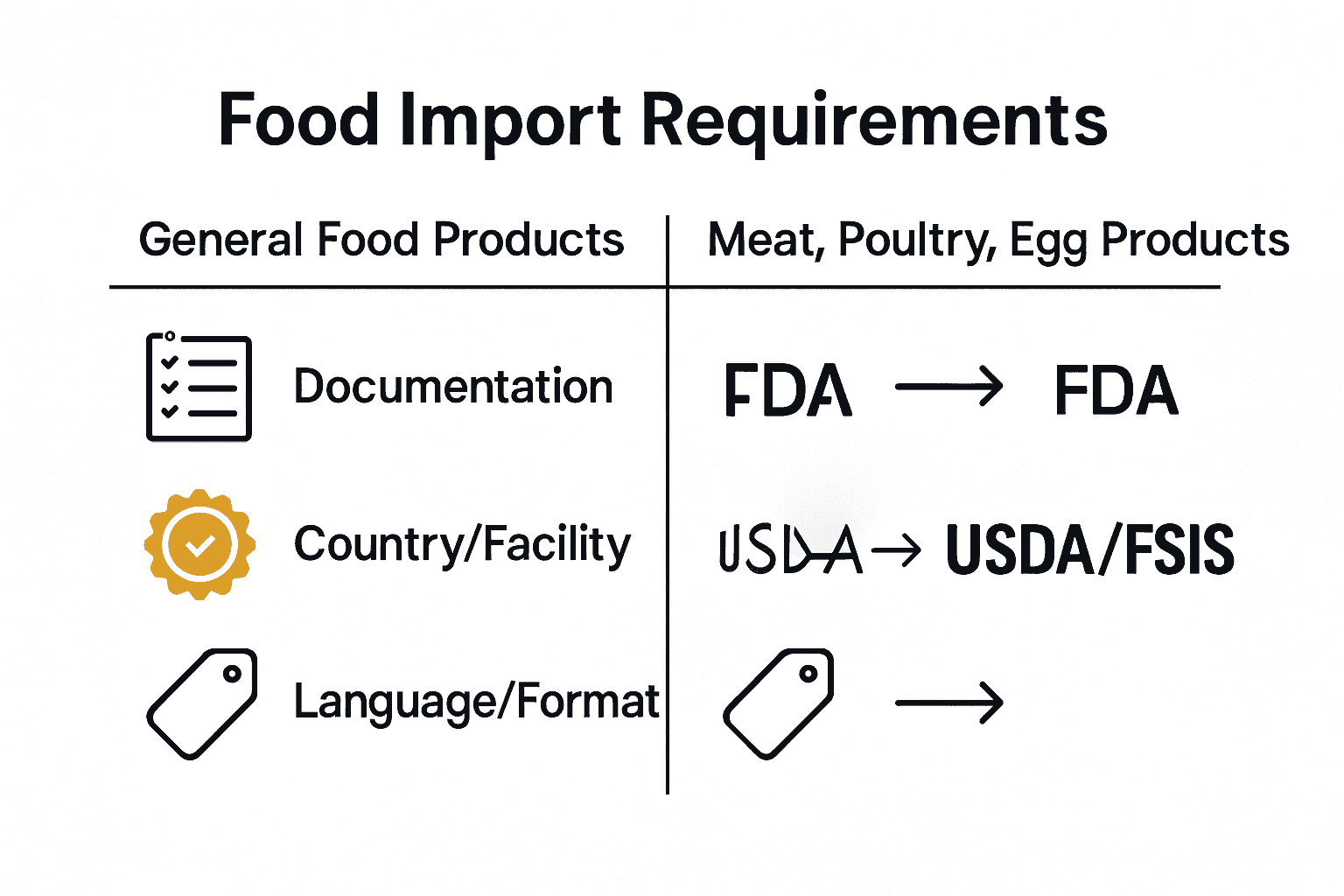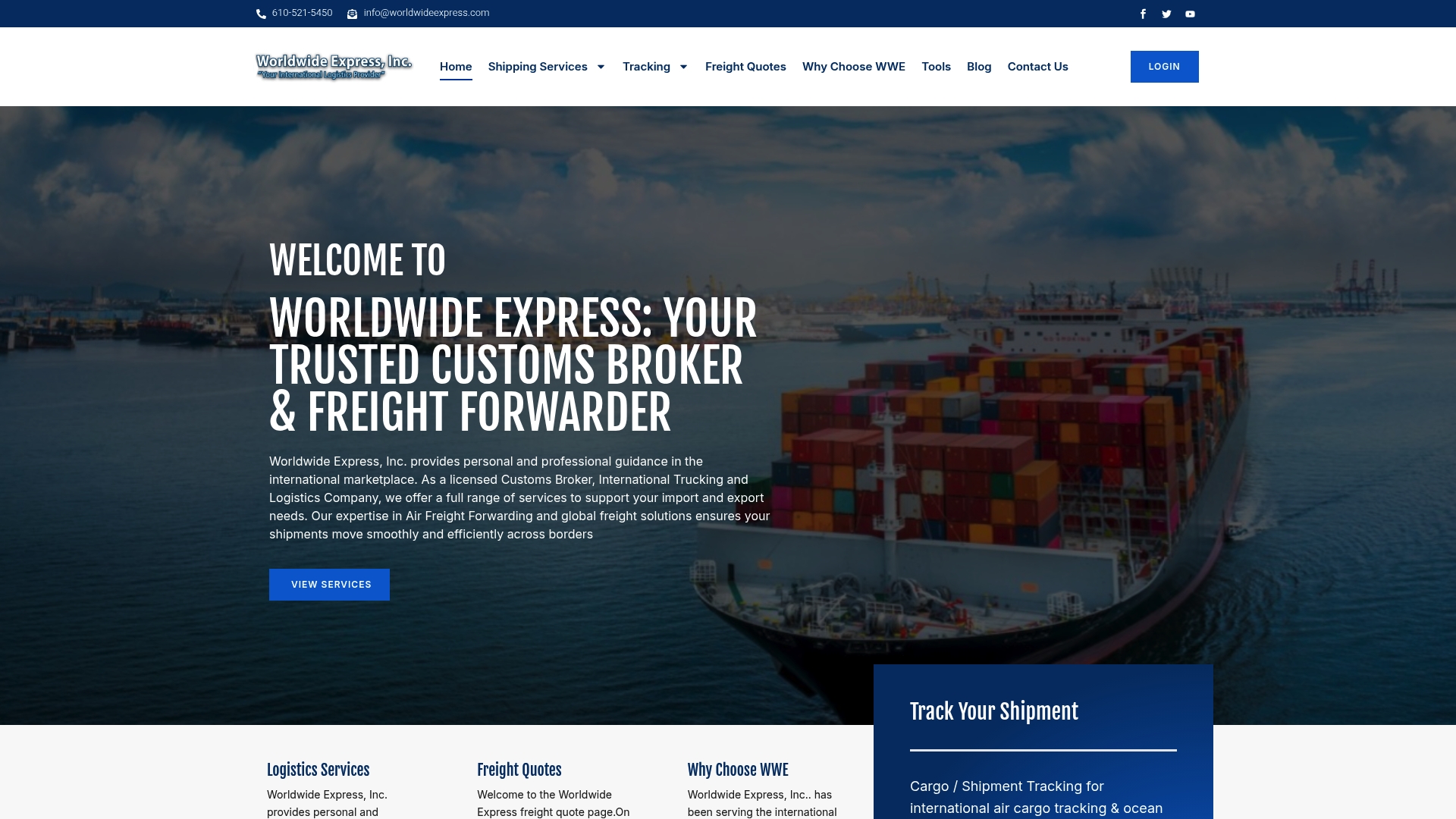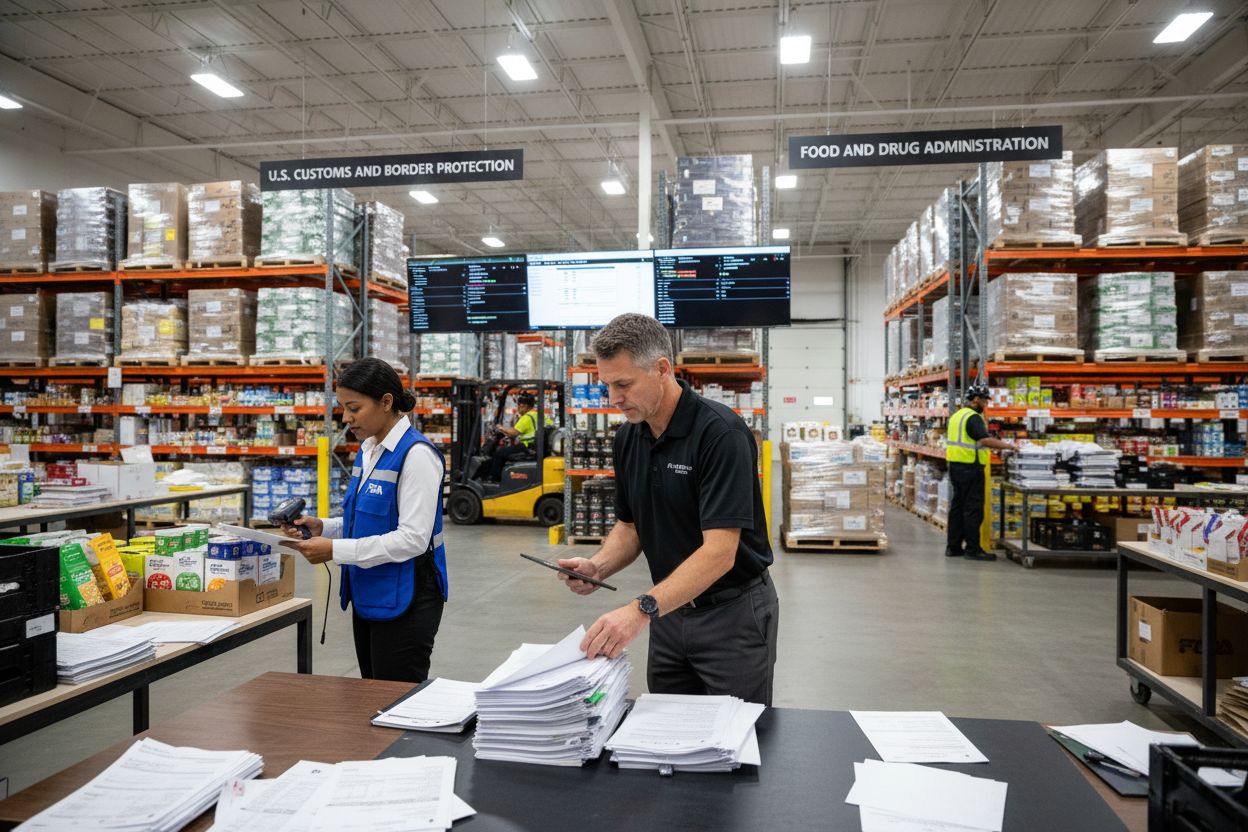Every year, the US blocks thousands of food shipments at the border for not meeting strict regulations. Importing food products is far more demanding than many suppliers realize. If one step is missed or a label is wrong, you could face costly delays or even watch your shipment be destroyed. Understanding exactly what authorities require is your first line of defense to keep your products moving safely through customs and onto store shelves.
Quick Summary
| Key Point | Explanation |
|---|---|
| 1. Understand Import Requirements First | Verify regulatory guidelines and eligibility to ensure compliance with federal standards for each food product. |
| 2. Prepare Comprehensive Regulatory Documents | Collect all required documentation, including facility registration and health certificates, to demonstrate safety compliance. |
| 3. Choose Experienced Logistics Partners | Work with customs brokers familiar with food import regulations to help navigate complex customs processes effectively. |
| 4. Execute Precise Customs Clearance | Ensure accurate documentation and compliance with FDA standards during customs to prevent shipment delays or rejections. |
| 5. Maintain Documentation for Compliance Checks | Keep essential records accessible to promptly address any federal inquiries or inspection requirements that arise. |
Table of Contents
- Step 1: Assess Import Requirements And Product Eligibility
- Step 2: Prepare Regulatory Documents And Certifications
- Step 3: Secure Reliable Logistics And Supply Chain Partners
- Step 4: Execute Customs Clearance And Fda Entry Procedures
- Step 5: Verify Delivery And Ensure Product Compliance
Step 1: Assess Import Requirements and Product Eligibility
When importing food products into the United States, your first critical step is understanding and verifying import requirements for your specific goods. This means diving deep into regulatory guidelines and ensuring every detail meets federal standards.
Start by identifying which government agencies regulate your specific food product. According to the FDA guidelines on food imports, importers carry full responsibility for guaranteeing their products are safe, sanitary, and correctly labeled. This isn’t just a recommendation it’s a mandatory requirement that could make or break your entire import operation.
For meat, poultry, and egg products, you’ll need to navigate additional requirements. The USDA Food Safety and Inspection Service mandates that these products can only originate from certified countries and establishments through a rigorous equivalence process. Each potential source must prove they meet stringent safety and quality standards before being permitted to export to the US.
Pro Tip: Create a detailed checklist for each product category. Track every regulatory requirement meticulously to prevent potential shipment delays or rejections.
Your import eligibility checklist should include several key verifications:
- Product origin certification
- Facility registration with FDA
- Proper labeling in English
- Compliance with USDA animal product regulations
- Advanced shipment notifications
Here’s a summary of key food import requirements by product category:

| Requirement | General Food Products | Meat, Poultry, Egg Products |
|---|---|---|
| Agency Oversight | FDA | USDA FSIS FDA |
| Country/Facility Certification | Not always required | Certified country & facility |
| Labeling Requirements | English FDA format |
English USDA/FSIS format |
| Special Certifications | None for most | Health certificate Residue test |
| Prior Notice to FDA | Yes | Yes |
| Unique Documentation Needed | Facility registration Affirmation of Compliance |
Facility registration Equivalence Determination |
Remember that US customs and regulatory agencies take food safety seriously. Read more about import guidelines to understand the full scope of requirements. Any non-compliance could result in shipment detention or complete rejection at the border.
In the next step, you will translate these requirements into actionable documentation and prepare your comprehensive import application.
Step 2: Prepare Regulatory Documents and CertificationsPreparing your regulatory documents is where the real work of importing food products begins. You will transform complex federal requirements into a comprehensive documentation package that demonstrates your commitment to food safety and compliance.According to FDA regulations, foreign food facilities must register every two years and implement specific verification programs. Your first task is gathering all required documentation. According to research from FDA guidelines, this includes food facility registration, health certificates, detailed invoices, bills of lading, and Affirmation of Compliance codes that help expedite screening processes.The Foreign Supplier Verification Program under the Food Safety Modernization Act is a critical component of your documentation. You will need to prove that your foreign suppliers meet US food safety standards. This means collecting comprehensive documentation about production processes, sanitation practices, and quality control mechanisms.> Pro Tip: Create a digital folder with scanned copies of all original documents. Having a well organized backup can save you tremendous time if physical documents are lost or damaged.
 Different food categories require specific documentation. Seafood and juice products need additional HACCP certification demonstrating hazard analysis and critical control point compliance. Your documentation package should include:
Different food categories require specific documentation. Seafood and juice products need additional HACCP certification demonstrating hazard analysis and critical control point compliance. Your documentation package should include:
- Original facility registration certificates
- Health and safety compliance documents
- Detailed product specifications
- Transportation and handling logs
- Certification of origin
- FDA Prior Notice forms
For importers seeking faster processing, learn more about the Voluntary Qualified Importer Program which offers expedited review for consistently compliant importers.
In the next step, you will submit these comprehensive documents for initial government review and begin preparing for potential product inspections.
Step 3: Secure Reliable Logistics and Supply Chain Partners
Navigating the complex world of food product imports requires building a robust network of logistics and supply chain partners who understand the intricate regulatory landscape. Your goal is to assemble a team that can seamlessly move your products through customs while maintaining compliance with federal regulations.
According to import guidelines from the FDA, most importers work with licensed customs brokers or entry filers to submit critical documentation and navigate port logistics. These professionals become your frontline experts in managing the intricate process of bringing food products into the United States.
When selecting your logistics partners, prioritize those with proven experience in food import regulations. They should be intimately familiar with systems like PREDICT that the FDA uses for screening imported goods. Learn more about understanding logistics providers to make an informed selection.
Pro Tip: Request detailed references and verify each potential partner’s track record with FDA regulated food imports. Experience matters more than cost when it comes to regulatory compliance.
Your ideal logistics partner will offer comprehensive services including:
- Customs documentation preparation
- FDA regulatory compliance support
- Advanced tracking and monitoring systems
- Risk management strategies
- Efficient transportation and warehousing solutions
Remember that providing accurate registration details, precise labeling information, and complete Foreign Supplier Verification Program documentation can significantly reduce the likelihood of shipment delays. The more meticulously you prepare, the smoother your import process will be.
In the next step, you will initiate your first shipment and begin the critical process of navigating customs clearance.
Step 4: Execute Customs Clearance and FDA Entry Procedures
You are now entering the most critical phase of your food import journey where your meticulous preparation will be put to the ultimate test. Executing customs clearance and FDA entry procedures requires precision and comprehensive understanding of complex regulatory requirements.
According to FDA import guidelines, your imported shipments must undergo rigorous review before entering US commerce. US Customs and Border Protection will handle entry declarations while working closely with your customs broker to ensure every detail meets regulatory standards.
A significant recent development demands your attention. Research indicates that as of July 9, 2025, the FDA has revoked prior exemptions for low-value shipments. This means every single FDA-regulated import—regardless of its monetary value—will be subject to full screening and increased oversight.
Pro Tip: Double-check every single document before submission. Even minor discrepancies can trigger extensive reviews or potential shipment rejection.
Your customs entry process will involve several critical steps:
- Submitting comprehensive entry documentation
- Paying applicable duties and taxes
- Providing detailed product specifications
- Confirming all FDA regulatory requirements
- Obtaining necessary admissibility determinations
Learn more about understanding customs entry procedures to streamline your import process. Remember that shipments found adulterated, misbranded, or restricted may be refused and could require immediate export or destruction.
In the next step, you will prepare for potential product inspections and final clearance verification.
Step 5: Verify Delivery and Ensure Product Compliance
Congratulations. Your food products have arrived at the US port and now face their ultimate challenge: passing rigorous federal compliance inspections. This final stage determines whether your shipment will enter US commerce or be turned away at the border.
According to USDA Food Safety and Inspection Service guidelines, different product categories undergo specialized verification processes. For meat, poultry, and egg products, this means comprehensive residue and microbial testing. Every label will be meticulously examined to confirm it meets English language requirements and includes all mandated product information.
The FDA employs multiple verification strategies. Import regulations indicate that your shipment may face examinations including sample analyses, facility registration checks, and potential import alerts. A single discrepancy could trigger a Detention Without Physical Examination status.
Pro Tip: Keep comprehensive documentation immediately accessible. Swift response to any compliance queries can mean the difference between shipment release and complete rejection.
Your compliance verification checklist should include:
- Confirming accurate product labeling
- Verifying microbial testing results
- Checking chemical residue standards
- Ensuring all facility registrations are current
- Preparing for potential reinspection
Learn more about international trade compliance to stay ahead of evolving regulatory requirements. Remember that shipments flagged for non-compliance may be detained or refused entry unless immediate corrective actions are taken.
In the final step, you will process any necessary corrections and prepare for potential distribution or alternative shipping arrangements.
Simplify Your Food Imports with Trusted US Logistics Experts
Struggling to keep up with rigorous food import requirements, endless paperwork, and high-stakes customs inspections? If you are facing the challenge of FDA registration, detailed documentation, and tight compliance checks, you are not alone. Many businesses feel the pressure to streamline their importing process but worry about costly delays or rejected shipments. That is where Worldwide Express, Inc. steps in. For importers navigating everything from facility registration and customs brokerage to global tracking and warehousing, our seasoned team delivers solutions built on decades of industry experience. Our team understands the pain points highlighted in the Master Importing Food Products US Guide from regulatory gaps to unpredictable supply chains. We are ready to guide you every step of the way.

Why take risks with your next food shipment? Experience stress-free imports with our full-service approach. Get expert support for compliance, documentation, and fast customs clearance when you visit Worldwide Express, Inc.. Or review more industry insights and solutions in our Uncategorized section. Do not wait until new regulations go into effect. Contact our team now and open the door to reliable, tailored logistics for your next US food import.
Frequently Asked Questions
What are the initial requirements for importing food products into the US?
To begin importing food products, you must first assess import requirements specific to your goods. Identify the regulatory agencies involved, gather necessary product certifications, and ensure compliance with labeling standards.
How do I prepare the necessary documentation for importing food products?
To prepare your documentation, compile essential forms such as the food facility registration and health certificates. Organize these documents in a digital folder to streamline the importing process and ensure everything is readily accessible when needed.
What role do logistics partners play in the food import process?
Logistics partners help navigate customs and regulatory compliance during the import process. Select experienced customs brokers who can manage documentation and facilitate smooth clearance to minimize delays and ensure compliance with regulations.
How do I execute customs clearance for my imported food products?
To execute customs clearance, submit detailed entry documentation, pay applicable duties, and confirm all regulatory requirements. Ensure accuracy in all submitted documents to avoid extensive reviews or shipment rejection.
What compliance checks should I perform upon delivery of imported food products?
Upon delivery, verify that all product labels meet requirements and check microbial testing results. Keep comprehensive records readily accessible to swiftly address any compliance issues that may arise during inspections.
How can I ensure my imported food products remain compliant throughout the process?
Maintain constant communication with your suppliers about their safety practices and comply with the Foreign Supplier Verification Program. Regularly update and review your documentation to anticipate changes in regulations and ensure ongoing compliance.
Recommended
- Master Exporting Food Products: A Step-by-Step Approach – Worldwide Express, Inc.
- How to Import Goods: A Step-by-Step Guide for Success – Worldwide Express, Inc.
- Mastering Your Export License Application Process – Worldwide Express, Inc.
- Understanding Import Export Basics for Global Trade – Worldwide Express, Inc.






